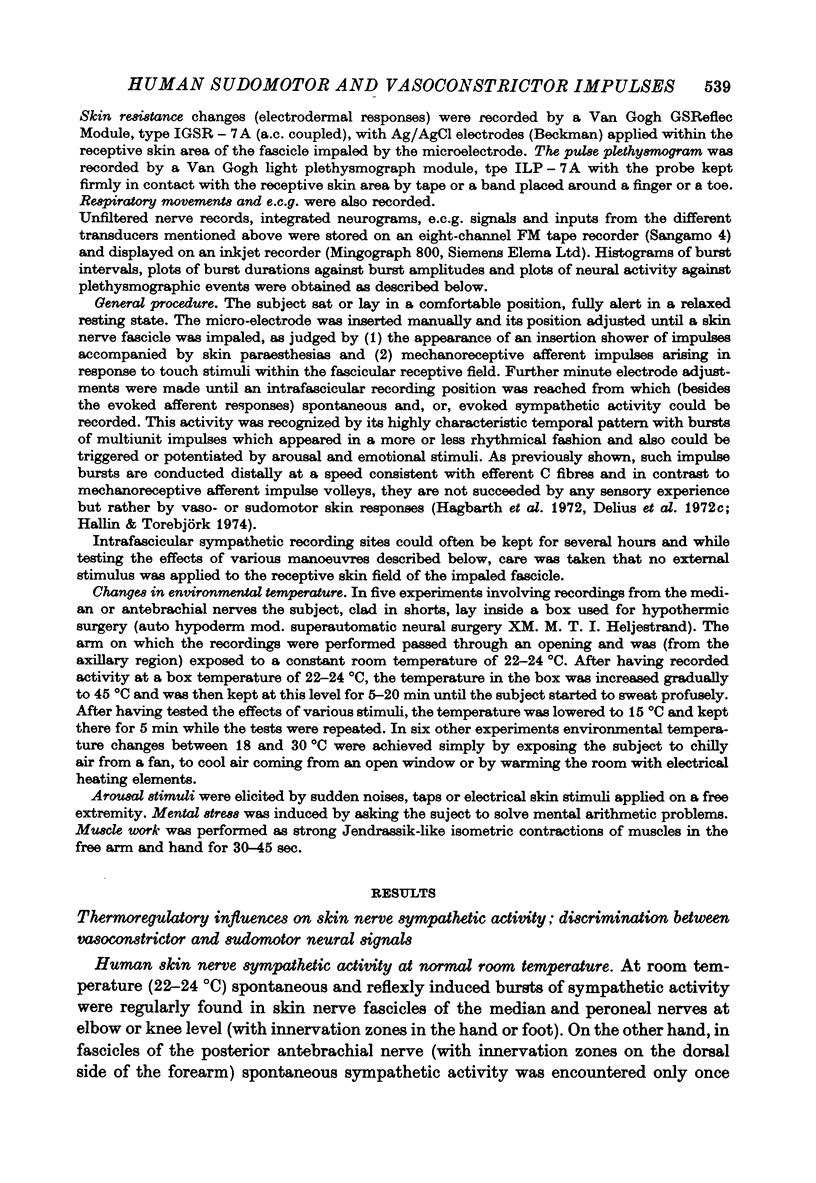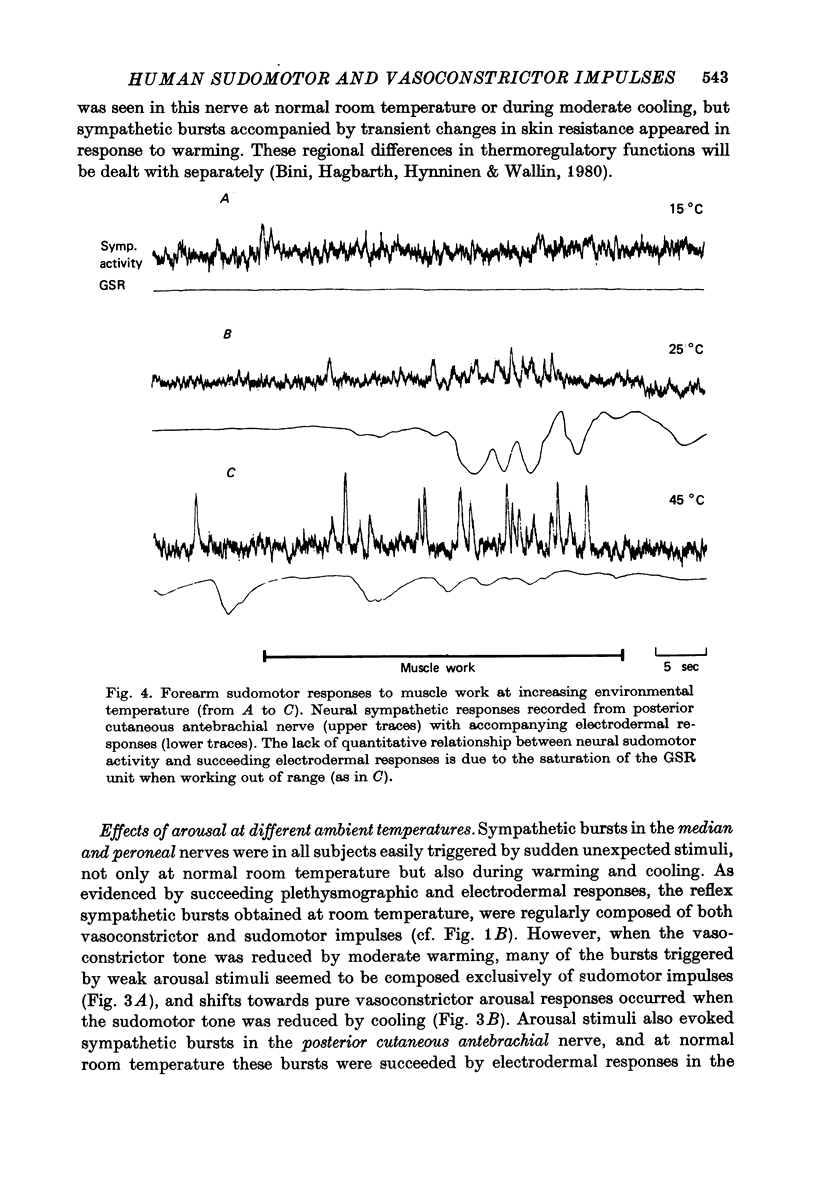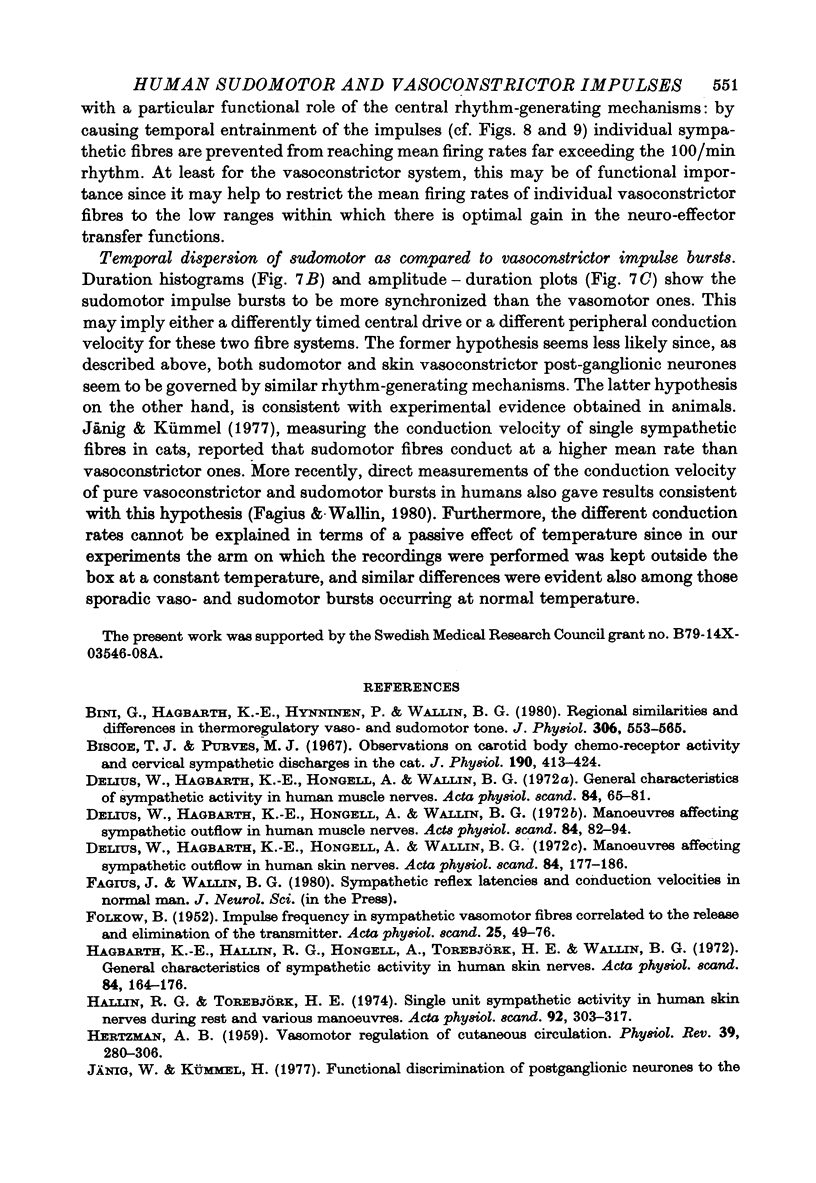Abstract
1. Recordings of multiunit sympathetic activity were made from human nerve fascicles supplying hairy and glabrous skin of the extremities in healthy subjects exposed to different ambient temperatures. Sudomotor and vasomotor events accompanying the neural activity were monitored by simultaneous recordings of electrodermal and pulse plethysmographic events (Pleth) in the neural innervation zones. 2. By exposing the subject to warm (43 degrees C) or cold (15 degrees C) environments, it was possible to obtain a selective activation of either the sudomotor or the vasoconstrictor neural system, respectively, with suppression of spontaneous activity in the other system. 3. Bursts of both vasoconstrictor and sudomotor nerve activity were found to occur at certain preferred intervals which were integer multiples of a period of about 0 . 6 sec (100 cycles/min). With high sudomotor or vasoconstrictor tone the 100 cycles/min rhythm was prominent but with decreasing tone slower subharmonic rhythms prevailed. Respiratory rhythms were also discerned as well as slower rhythms attributable to oscillatory tendencies in thermoregulatory servos. 4. Vasoconstrictor bursts had longer mean duration than sudomotor bursts, a finding attributed to a slower conduction velocity of vasoconstrictor as compared to sudomotor impulses. 5. With increasing incidence of bursts transient electrodermal or plethysmographic responses following individual bursts merged, and thus the fast neural rhythms were not discernible in either the electrodermal or Pleth traces. Given increments in firing rate of nerves produced less additional vasoconstriction at high than at low firing rates. The rhythm generating mechanisms may help to restrict rates of individual fibres to the low range which provides high gain in the neuroeffector transfer functions.
Full text
PDF















Selected References
These references are in PubMed. This may not be the complete list of references from this article.
- Bini G., Hagbarth K. E., Hynninen P., Wallin B. G. Regional similarities and differences in thermoregulatory vaso- and sudomotor tone. J Physiol. 1980 Sep;306:553–565. doi: 10.1113/jphysiol.1980.sp013414. [DOI] [PMC free article] [PubMed] [Google Scholar]
- Biscoe T. J., Purves M. J. Observations on carotid body chemoreceptor activity and cervical sympathetic discharge in the cat. J Physiol. 1967 Jun;190(3):413–424. doi: 10.1113/jphysiol.1967.sp008218. [DOI] [PMC free article] [PubMed] [Google Scholar]
- Delius W., Hagbarth K. E., Hongell A., Wallin B. G. General characteristics of sympathetic activity in human muscle nerves. Acta Physiol Scand. 1972 Jan;84(1):65–81. doi: 10.1111/j.1748-1716.1972.tb05158.x. [DOI] [PubMed] [Google Scholar]
- Delius W., Hagbarth K. E., Hongell A., Wallin B. G. Manoeuvres affecting sympathetic outflow in human muscle nerves. Acta Physiol Scand. 1972 Jan;84(1):82–94. doi: 10.1111/j.1748-1716.1972.tb05157.x. [DOI] [PubMed] [Google Scholar]
- Delius W., Hagbarth K. E., Hongell A., Wallin B. G. Manoeuvres affecting sympathetic outflow in human skin nerves. Acta Physiol Scand. 1972 Feb;84(2):177–186. doi: 10.1111/j.1748-1716.1972.tb05168.x. [DOI] [PubMed] [Google Scholar]
- HERTZMAN A. B. Vasomotor regulation of cutaneous circulation. Physiol Rev. 1959 Apr;39(2):280–306. doi: 10.1152/physrev.1959.39.2.280. [DOI] [PubMed] [Google Scholar]
- Hagbarth K. E., Hallin R. G., Hongell A., Torebjörk H. E., Wallin B. G. General characteristics of sympathetic activity in human skin nerves. Acta Physiol Scand. 1972 Feb;84(2):164–176. doi: 10.1111/j.1748-1716.1972.tb05167.x. [DOI] [PubMed] [Google Scholar]
- Hallin R. G., Torebjörk H. E. Single unit sympathetic activity in human skin nerves during rest and various manoeuvres. Acta Physiol Scand. 1974 Nov;92(3):303–317. doi: 10.1111/j.1748-1716.1974.tb05749.x. [DOI] [PubMed] [Google Scholar]
- Jänig W., Kümmel H. Functional discrimination of postganglionic neurones to the cat's hindpaw with respect to the skin potentials recorded from the hairless skin. Pflugers Arch. 1977 Nov 23;371(3):217–225. doi: 10.1007/BF00586261. [DOI] [PubMed] [Google Scholar]
- Ljung B., Bevan J. A., Pegram B. L., Purdy R. E., Su M. Vasomotor nerve control of isolated arteries and veins. Acta Physiol Scand. 1975 Aug;94(4):506–516. doi: 10.1111/j.1748-1716.1975.tb05910.x. [DOI] [PubMed] [Google Scholar]
- Normell L. A., Wallin B. G. Sympathetic skin nerve activity and skin temperature changes in man. Acta Physiol Scand. 1974 Jul;91(3):417–426. doi: 10.1111/j.1748-1716.1974.tb05696.x. [DOI] [PubMed] [Google Scholar]
- Sundlöf G., Wallin B. G. The variability of muscle nerve sympathetic activity in resting recumbent man. J Physiol. 1977 Nov;272(2):383–397. doi: 10.1113/jphysiol.1977.sp012050. [DOI] [PMC free article] [PubMed] [Google Scholar]
- Taylor D. G., Gebber tgl Baroreceptor mechanisms controlling sympathetic nervous rhythms of central origin. Am J Physiol. 1975 Apr;228(4):1002–1003. doi: 10.1152/ajplegacy.1975.228.4.1002. [DOI] [PubMed] [Google Scholar]
- Vallbo A. B., Hagbarth K. E., Torebjörk H. E., Wallin B. G. Somatosensory, proprioceptive, and sympathetic activity in human peripheral nerves. Physiol Rev. 1979 Oct;59(4):919–957. doi: 10.1152/physrev.1979.59.4.919. [DOI] [PubMed] [Google Scholar]


